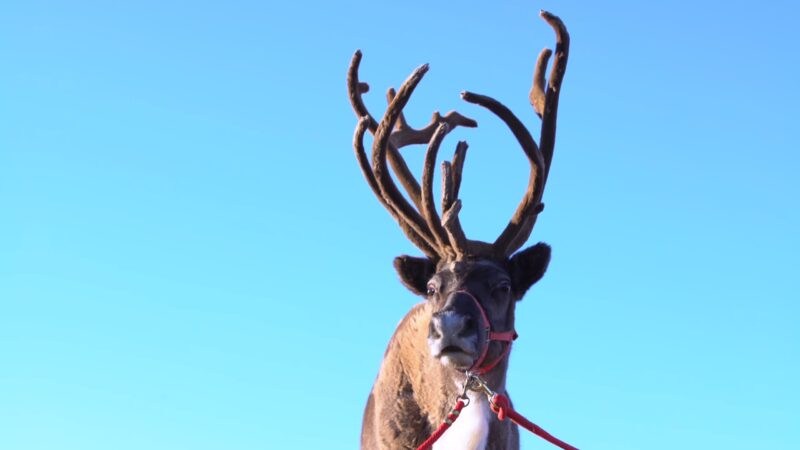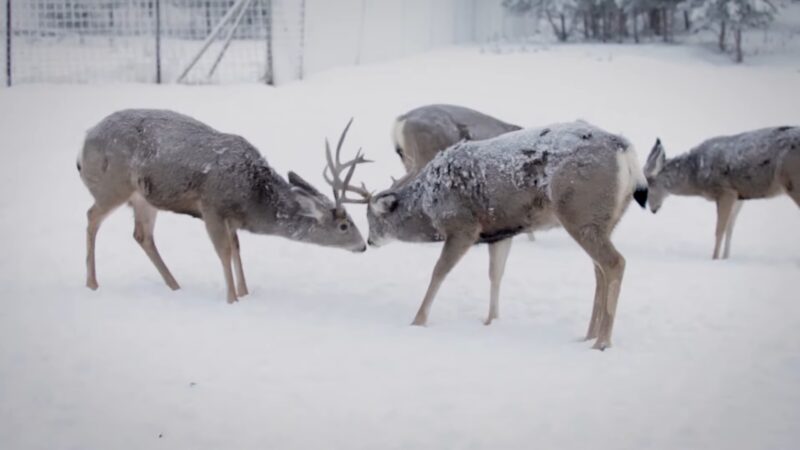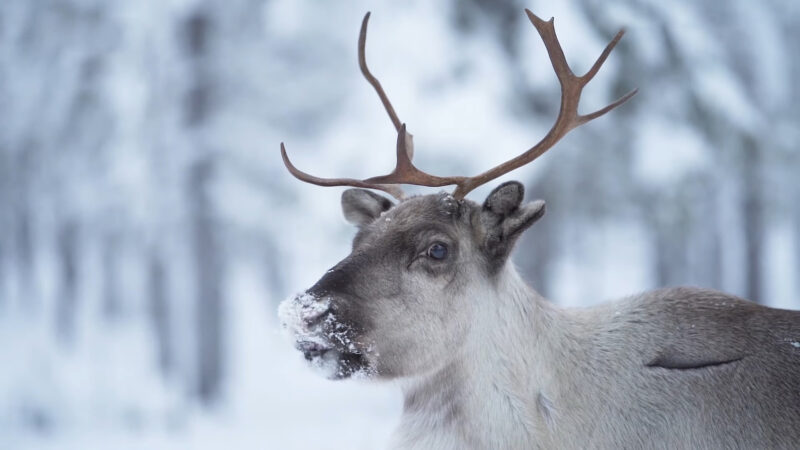The animal kingdom is full of intriguing and unique characteristics that differentiate species. One such fascinating aspect lies in the world of deer, specifically concerning the presence of antlers.
While it’s a common notion that antlers are a male trait among deer, there’s an exception in females. Today, we will explore this unique case and contrast it with other deer species, discovering the biological and ecological significance behind this phenomenon.
Antlers in the Deer Family

In most deer species, antlers are a male-dominated feature. They are typically used for mating rituals, such as fighting for dominance and attracting females.
This characteristic is most commonly observed in species like white-tailed deer, moose, and elk.
Female Reindeer: An Exception
Contrary to the general rule, both male and female reindeer grow antlers. This unique trait makes reindeer an exceptional case in the cervid family.
But why do females have antlers, and how do they differ from their male counterparts?
Morphological Differences
Males usually boast larger and thicker antlers, primarily used in combat for mating rights. In contrast, female reindeer have smaller, more slender antlers.
Despite being less robust, these antlers play a crucial role in the survival and reproductive success of female reindeer.
Shedding Patterns
An interesting aspect of reindeer antler biology is their shedding pattern. Males typically shed their antlers in early winter, past the mating season.
Females, however, retain theirs throughout winter until they give birth in the spring. This retention by females during harsh winters is an adaptive trait with significant benefits.
The Biological Significance of Antlers in Female Reindeer
- Survival and Foraging: Antlers in female reindeer are not just ornamental, as they serve critical survival functions. During the challenging winter months, these antlers are used to break through snow to access food, a vital action for their sustenance.
- Reproductive Advantage: The retention of antlers by pregnant females until after giving birth in spring is a strategic evolutionary adaptation. It is believed that antlers may provide an advantage in defending food resources, crucial for the health of the expectant mother and the development of the fetus.
The Life Cycle of a Female Reindeer
Reproduction
Female reindeer, known as cows, typically give birth to one calf annually, although twins are possible.
The gestation period and reproductive success are closely linked to the cow’s health and environmental conditions.
Antler Growth and Development
The growth of antlers in female reindeer is a fascinating process. These antlers develop from bony outgrowths on the skull, covered in a nutrient-rich velvet.
This velvet supplies blood and nutrients essential for the rapid growth of antlers.
Ecological and Cultural Significance
- Role in Ecosystems: Reindeer, both males and females, play a crucial role in their native ecosystems. They influence vegetation patterns and serve as key prey species for predators, maintaining ecological balance.
- Place in Culture: Reindeer have a significant place in the cultures of indigenous peoples in the Arctic and Subarctic regions. The unique trait of antlers in female reindeer has added to their cultural and symbolic importance in these communities.
The Evolutionary Perspective
Adaptive Significance in Harsh Environments
The evolution of antlers in female reindeer is a testament to nature’s adaptability. In the harsh Arctic and Subarctic climates where reindeer reside, food scarcity during winter months is a critical challenge.
Female reindeer use their antlers effectively for foraging, providing them an evolutionary advantage in these extreme conditions.
Genetic and Environmental Factors
The development of antlers in female reindeer is influenced by both genetic and environmental factors.
Studies suggest that the expression of antlers in females is closely linked to the availability of resources and the harshness of the environment, shaping their evolutionary path.
Antler Growth Cycle in Female Reindeer

The antler growth cycle in female reindeer is an annual process. Each year, after giving birth, they shed their antlers, and a new set begins to grow.
This cycle is regulated by hormonal changes and environmental cues, showcasing a remarkable example of biological synchronicity with their surroundings.
The Role of Hormones
Hormonal regulation plays a pivotal role in antler growth. The levels of hormones like estrogen influence the growth cycle of antlers in female reindeer.
This hormonal interplay is a key area of study for understanding the unique physiology of these animals.
The Role of Antlers in Social Structure
Hierarchical Significance
In reindeer societies, antlers play a role in establishing social hierarchies. Females with larger antlers often have a higher social standing, which can influence their access to resources and overall health.
Communication and Behavior
Antlers are not just for foraging and combat; they also serve as tools for communication, as stated in this case study, and behavioral expressions among reindeer.
The size and posture of antlers can convey messages related to dominance, mating readiness, and territoriality.
Threats to Habitat and Survival
Climate change poses significant threats to reindeer habitats, impacting food availability and the ecological balance crucial for the survival of these species.
Understanding the role of antlers in female reindeer survival is crucial for effective conservation efforts.
Conservation Strategies
Efforts to conserve reindeer populations must consider the unique biological needs of female reindeer, including the significance of their antlers.
Protecting their habitats and ensuring sustainable management practices are key components of these strategies.
FAQs
Can you differentiate between male and female reindeer antlers just by looking?
Yes, generally you can. Males’ antlers tend to be larger and more complex, while females are typically smaller and less branched.
Do antlers in female reindeer grow at the same rate as in males?
No, they usually grow at a slower rate. Males’ antlers grow rapidly during the mating season, driven by high testosterone levels, whereas female antler growth is steadier and less influenced by seasonal hormonal changes.
Are there any health issues associated with antler growth in female reindeer?
Yes, poor nutrition or health issues can affect antler growth in female reindeer. Inadequate diet, for instance, can lead to smaller or malformed antlers, which may impact their survival and social standing.
Is the velvet covering on antlers unique to female reindeer?
No, both males and females grow velvet on their antlers. This velvet is a soft tissue that supplies nutrients and blood, and it’s eventually shed as the antlers harden.
Do female reindeer use their antlers in mating rituals like males?
Not typically. While males use them primarily for fighting and displaying during mating rituals, females use them more for foraging and defending resources.
Are there any other deer species where females grow antlers?
Yes, though it’s rare. In some species, like the Chinese water deer, females occasionally grow antlers, but this is an anomaly rather than a regular occurrence. Females are unique in that they consistently grow antlers as a normal trait.
Concluding Thoughts
The phenomenon of antlers in female reindeer is not just a curiosity but a significant adaptation that reveals much about survival strategies in harsh environments.
It underscores the importance of knowledge about unique biological traits for effective conservation and wildlife management.
The presence of antlers in female reindeer is a unique adaptation that provides critical insights into evolutionary biology, ecological balance, and conservation.
Their study enhances our knowledge of how species adapt and thrive in challenging environments, offering lessons that extend far beyond the tundra.
Related Posts:
- Why Do Moose Have Antlers? - From Decoration to Weaponry
- Difference Between Male and Female Bald Eagles:…
- Spot The Difference Between A Male and Female Bear
- How Many Stomachs Does a Cow Have? - Explained!
- Do Sharks Have Tongues? (Revealing the Hidden Depths)
- Do Bears Have Tails? - Find Out the Truth Here








